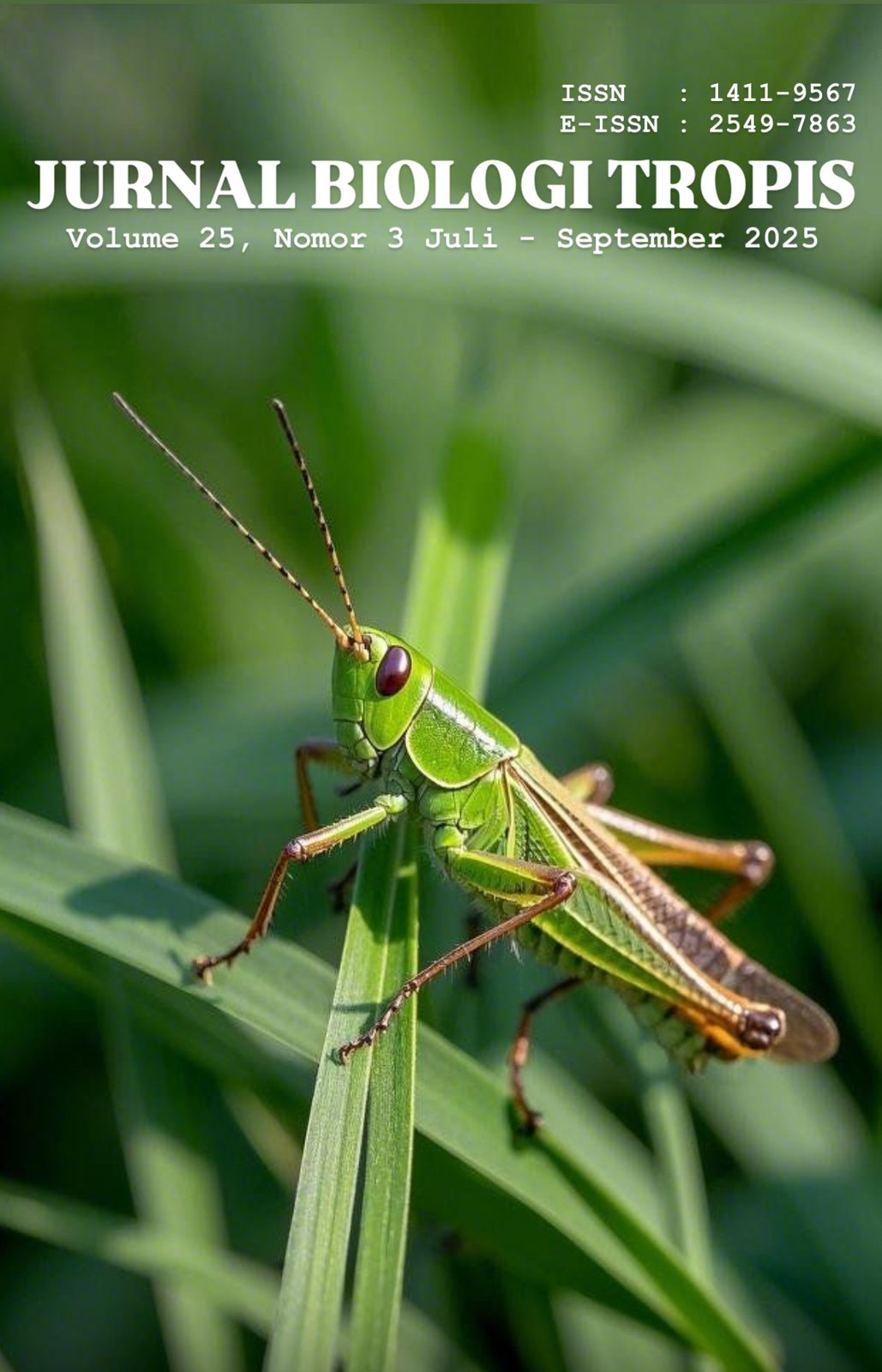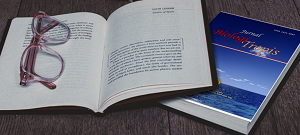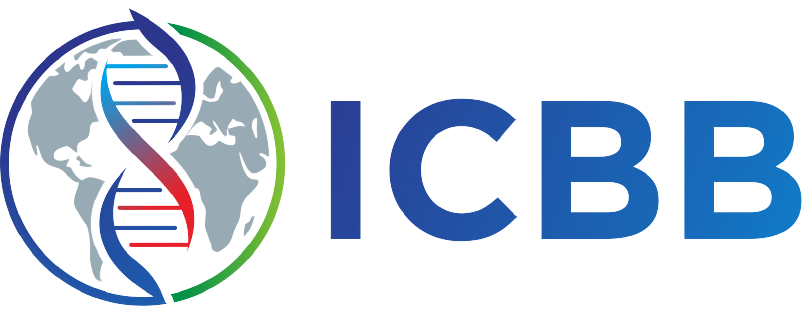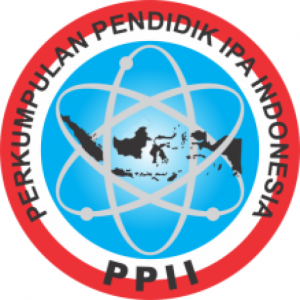The Effect of Substrate on The Growth and Survival of Abalone (Haliotis squmata) Recirculation System
Authors
Yusrin Yusrin , Abdul Syukur , Muhammad JunaidiDOI:
10.29303/jbt.v25i3.9642Published:
2025-07-18Issue:
Vol. 25 No. 3 (2025): Juli-SeptemberKeywords:
Abalone (Haliotis squamata), growth, recirculation system, substrate.Articles
Downloads
How to Cite
Downloads
Metrics
Abstract
Abalone (Haliotis squamata) is a high-value economic commodity that has great potential for cultivation, but selecting the right substrate is a key factor in increasing cultivation productivity because it affects the level of attachment, feeding activity, growth, and survival in a recirculation system The purpose of this study was to determine the effect of the right substrate in supporting the growth and survival of abalone (Haliotis squamata).This study used an experimental method with a Completely Randomized Design (CRD) with 5 substrate treatments (coral, gravel, sand, coral + sand, gravel + sand) with 3 replications. A total of 20 abalone seeds measuring 1.5-2.5 cm were reared for 60 days. The parameters observed included absolute length growth, absolute weight, specific growth rate (SGR), and survival rate (SR) measured every 15 days. Data were analyzed using ANOVA and a follow-up LSD test. The parameters observed included shell length increase, absolute weight, specific growth rate, survival rate, and water quality. The results showed that the coral reef substrate supported a growth rate of 0.94% per day with an 83% survival rate, while the sand substrate showed a growth rate of 0.59% per day with a 57% survival rate. It was concluded that the best treatment on the coral reef substrate.
References
Aldon, E. (2007). Artificial diet development The development of artificial diets for abalone: A review and future directions. Aquaculture. 19(2), 24–38.
Basir, A.p., Abidin, j., & Sanipan, D. (2023). Efektivitas Suhu Terhadap Kelangsungan Hidup Kerang Abalone (Haliotis squamata). Jurnal Borneo Saintek, 6(1), 32–39. Available online at www.jurnal.borneo.ac.id
Budi, Hadijah, S., & Viky, Z. E. (2015). The Influence of Substrate to Larval Settlement of the Tropical Abalone (Haliotis asinina). Modern Applied Science, 9(1), 184–188. https://doi.org/10.5539/mas.v9n1p184
Bulan, J. C., Hendrawan, I. G., & Ria Puspitha, N. L. P. (2020). Analisis Kelimpahan dan Identifikasi Predator Abalon (Haliotis squamata) di Pantai Geger, Nusa Dua, Bali. Journal of Marine Research and Technology, 3(1), 1–5. https://doi.org/10.24843/jmrt.2020.v03.i01.p01
Effendy, I. J., Nurdin, A. R., Mu’minun, N., Ridwar, D., & Saridu, S. A. (2022). Studi Makroalga Sebagai Biofilter Terhadap Pertumbuhan dan Sintasan Juvenil Abalon (Haliotis asinina) Pada Sistem Budidaya Resirkulasi. Jurnal Salamata, 4(2), 36–44. https://doi.org/10.15578/salamata.v4i2.12330
Gapasin, R. S. J., & Polohan, B. B. (2005). Response of the Tropical Abalone, Haliotis asinina, Larvae on Combinations of Attachment Cues. Hydrobiologia, 548(1), 301–306. https://doi.org/10.1007/s10750-005-0754-8
Hamid, F., Effendy, I. J., Rahman, A., D. (2016). Studi Pemberian Pakan Diatom dan Makroalga terhadap Pertumbuhan dan Sintasan Juvenil Abalon (Haliotis asinina) pada Sistem IMTA (Integrated Multi Trophic Aquaculture). Media Akuatika, 1(2), 193–205. http://doi.org/10.33772/jma.v2i2.4329
Hayati, H., Dirgayusa, I. G. N. P., & Puspitha, N. L. P. R. (2018). Laju Pertumbuhan Kerang Abalon Haliotis squamata Melalui Budidaya IMTA (Integrated Multi Trophic Aquaculture) di Pantai Geger, Nusa Dua, Kabupaten Badung, Provinsi Bali. Journal of Marine and Aquatic Sciences, 4(2), 253–262. https://doi.org/10.24843/jmas.2018.v4.i02.253-262
Humaidi, Rejeki, S., & Ariyati, R. W. (2014). Pembesaran Siput Abalon (Haliotis squamata) Dalam Karamba Tancap di Area Pasang Surut dengan Padat Tebar yang Berbeda. Journal of Aquaculture Management and Technology, 3(4), 214–221. http://ejournal-s1.undip.ac.id/index.php/ jamt
Iskandar, A., AB Jannar, A Sujangka, & Muslim, M. (2022). Teknologi Pembenihan Abalon Haliotis squamata Untuk Meningkatkan Produksi Budidaya Secara Berkelanjutan. Samakia : Jurnal Ilmu Perikanan, 13(1), 17–31.
https://doi.org/10.35316/jsapi.v13i1.1675
Kawakibi, K. (2016). Teknik Pembesaran Abalon (Haliotis asinina) di Balai Perikanan Budidaya Laut Lombok, Nusa Tenggara Barat. Skripsi, 1–65.
Kurnia, A. (2013). Keragaman Genetik Abalon (Haliotis asinina) Perairan Madura Dan Abalon (Haliotis squamata) Perairan Bali Menggunakan Analisis Pcr-Rflp dengan Marka Genetik 16s Rdna di Laboratorium Sentral Ilmu Hayati Universitas Brawijaya. Skripsi, 1–57.
Mau’ud, M., Junaidi, M., & Scabra, A. R. (2024). Jurnal Biologi Tropis The Effect of Depth on Growth and Survival of Abalone Shells (Haliotis sp .) with A Multi-Level System. Junal Biologi Tropis, 24(3), 403–411. http://doi.org/10.29303/jbt.v24i3.7346
Maharani, M., Patadjai, A. B., Hasidu, L. O. A. F., Riska, R., Muis, M., Anindita, F., & Disnawati, D. (2021). Kandungan Nutrisi Selama Pengolahan Haliotis asinina Linnaeus, 1758 (Gastropoda:Haliotidae). Journal of Marine Research, 10(4), 565–569. https://ejournal3.undip.ac.id/index.php/jmr
Nida, Q. (2023). Keanekaragaman Jenis Gastropoda di Zona Litoral Pantai Lhok Mata Ie Sebagai Pendukung Materi Keanekaragaman Hayati Di Sma Negeri 1 Peukan Bada Aceh Besar. (Skripsi, Fakultas Tarbiyah dan Keguruan, UIN Ar Raniry). Repository UIN Ar Raniry. https://repository.ar raniry.ac.id/id/eprint/31292
Nurfajrie, Suminto, & Rejeki, S. (2014). Pemanfaatan Berbagai Jenis Makroalga untuk Pertumbuhan Abalon (Haliotis squamata) dalam Budidaya Pembesaran. Journal of Aquaculture Management and Technology, 3(4), 142–150.http://ejournal-s1.undip.ac.id/index.php/jamt
Octaviany, M. J. (2007). Beberapa Catatan Tentang Aspek Biologi Dan Perikanan Abalon. Jurnal Oseana, 32(4), 39–47. sumber:www.oseanografi.lipi.go.id
Pattirane, C. P., Suryana, A., & Kawati, H. (2023). Pemanfaatan Makroalga Berbeda Untuk Meningkatkan Pertumbuhan dan Tingkat Kelangsungan Hidup Juvenil Abalon , Haliotis squamata ( Utilization Different Macroalgae to Enhance Growth and Survival Rate of Juvenile Abalone , Haliotis squamata ). 7(2), 88–96. https ://doi.org/ 10.54115/jmi.v7i2.92
Pebriani, D. A. A., & Dewi, D. A. P. W. K. (2016). Analisis daya Dukung Perairan Berdasarkan Kualitas Air Terhadap Peluang Budidaya Abalon (Haliotis sp.) di Perairan Kutuh, Bali. Jurnal Ilmu Perikanan, 7(2), 66–71. http://samakia.aperiki.ac.id/index.php/JSAPI
Peña, de la M. R., Bautista, J. I., Buen-Ursua, S. M., Bayona, N., & Titular, V. S. T. (2010). Settlement, Growth and Survival of the Donkey-s Ear Abalone Haliotis asinina (Linne) in Response to Diatom Diets and Attachmesnt Substrate. Philippine Journal of Science, 139(1), 27–34.
Purba, N. P. (2020). Unpad press. In Mengelola Laut Indonesia di Era Mahadata: Satu Data, Satu Bahasa, Satu Kebijakan. Kapita Selekta: Pokok Pikiran Perikanan dan Kelautan Indonesia
Rusdi, I., Rahmawati, R., Susanto, B., & Adiasmara, I. N. (2010). Pematangan Gonad Induk Abalon Haliotis Squamata Melalui Pengelolaan Pakan. Jurnal Riset Akuakultur, 5(3), 383–391. https://doi.org/10.15578/jra.5.3.2010.383-391
Viera, de pino M., Courtois de Viçose, G., Fernández-Palacios, H., & Izquierdo, M. (2014). Grow-Out Culture f Abalone Haliotis tuberculata Coccinea Reeve, Fed Land-Based IMTA Produced Macroalgae, In A Combined Fish/Abalone Offshore Mariculture System: Effect of Stocking Density. Aquaculture Research, 47(1), 1–11. https://doi.org/10.1111/are.12467
Wardi. (2022). Pengaruh Level Protein Pakan Buatan Terhadap Performa Reproduksi Abalon (Haliotis Squamata) Tropis. Skripsi, 1–29.
Xi, P., Qiao, Y., Cong, Q., & Cui, Q. (2024). Experimental Study on the Adhesion of Abalone to Surfaces with Different Morphologies. Biomimetics, 9(4), 1–12. https://doi.org/10.3390/biomimetics9040206
Zain, Y. G., Junaidi, M., & Mulyani, L. F. (2023). Pengaruh Substrat yang Berbeda terhadap Pertumbuhan dan Kelangsungan Hidup Kerang Abalon (Haliotis squamata) The Effect of Different Substrates on the Growth and Survival of Abalone (Haliotis squamata). Jurnal Laot Ilmu Kelautan, 5(2), 204–218. https://doi.org/10.35308/jlik.v5i2.8438
Zhang, Y., Li, S., Zuo, P., Li, J., & Liu, J. (2020). A Mechanics Study on the Self-Righting of Abalone from the Substrate. Applied Bionics and Biomechanics, 9(1), 1–6. https://doi.org/10.1155/2020/8825451
Zhu, S., Shen, J., Ruan, Y., Guo, X., Ye, Z., Deng, Y., & Shi, M. (2016). The effects of different seeding ratios on nitrification performance and biofilm formation in marine recirculating aquaculture system biofilter. Environmental Science and Pollution Research, 23(14), 14540–14548. https://doi.org/10.1007/s11356-016-6609-1
License
Copyright (c) 2025 Yusrin Yusrin, Abdul Syukur, Muhammad Junaidi

This work is licensed under a Creative Commons Attribution 4.0 International License.

Jurnal Biologi Tropis is licensed under a Creative Commons Attribution 4.0 International License.
The copyright of the received article shall be assigned to the author as the owner of the paper. The intended copyright includes the right to publish the article in various forms (including reprints). The journal maintains the publishing rights to the published articles.
Authors are permitted to disseminate published articles by sharing the link/DOI of the article at the journal. Authors are allowed to use their articles for any legal purposes deemed necessary without written permission from the journal with an acknowledgment of initial publication to this journal.


























